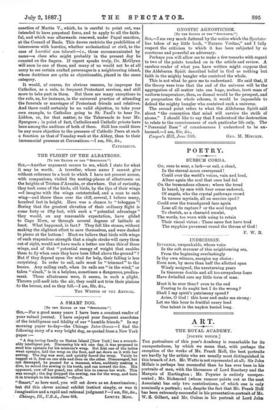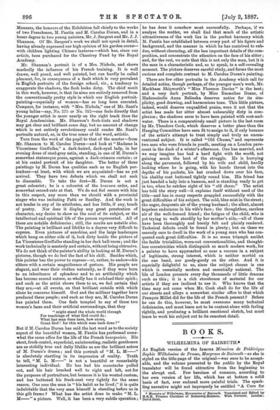ART.
THE ROYAL ACADEMY.
[FOURTH NOTICE.]
The portraiture of this year's Academy is remarkable for its unexpectedness, by which we mean that, with perhaps the exception of the works of Mr. Frank Holl, the beet portraits are hardly by the artists who are usually most distinguished in this branch of Art. Mr. Watts is not represented at all; Sir John Millaie is perhaps lees successful than be has ever been in his portraits of men, with the likenesses of Lord Roeebery and the Marquis of Hartington ; Mr. Poynter is entirely unrepre- sented ; Mr. Richmond (whom rumour points out as the next Associate) has only two contributions, of which one is only nominally a portrait; and, despite the fact that Mr. Frank Holt has been extremely successful in his presentation-portrait of Mr. W. B. Gilbert, and Mr. Oakes in his portrait of Lord John
Manners, the honours of the Exhibition fall chiefly to the works of two Frenchmen, M. Fantin and M. Carolns Duran, and in a lesser degree to two young painters, Mr. J. Sargent and Mr. J. J. Shannon. Of Mr. Sargent's work we shall not speak in detail, having already expressed our high opinion of his garden-scene- 'with children lighting Chinese lanterns—which has, since our article, been purchased for the Chantrey Fund by the Royal Academy.
Mr. Shannon's portrait is of a Mrs. Nichols, and shows markedly the influence of his French training. It is well drawn, well posed, and well painted, bat can hardly be called pleasant, for, in consequence of a fault which is very prevalent in English portraits of the foreign school, via., a tendency to exaggerate the shadows, the flesh looks dirty. The chief merit in this work, however, is that its aims are entirely removed from the conventionally pretty style in which our English portrait- painting—especially of women—has so long been executed. Compare, for instance, with "Mrs. Nichols," one of Mr. Sant's young ladies—say, No. 275 or No. 312—one feels directly that the younger artist is more nearly on the right track than the Royal Academician. Mr. Shannon's flesh-tints and shadows may get clear and brilliant some day, but no amount of change which is not entirely revolutionary could render Mr. Sant's portraits natural, or, in the true sense of the word, artistic.
Tarn from the work of the pupil to that of the master—from Mr. Shannon to M. Carolus Duran—and look at "Madame In Vicomtesse Greffulhe," a dark-haired, dark-eyed lady, in her evening dress of steel-grey satin, standing, in one of M. Duran's somewhat statuesque poses, against a dark-crimson curtain ; or at his seated portrait of his daughter. The better of these paintings by M. Duran has qualities such as no English por- traiture—at least, with which we are acquainted—has as yet arrived. They have two defects which we shall not seek to dissemble. To take the first—M. Duran is not a great colourist ; he is a colourist of the bravura order, and somewhat second-rate at that. We do not feel secure with him in this respect, any more than we should with a provincial singer who was imitating Patti or Santley. And the work is not tender in any of its attributes, and has little, if any, touch of poetry. Nor does it display any great penetration of character, any desire to show us the soul of its subject, or the intellectual and spiritual life of the person represented. All of these are notable deficiencies ; still, the merits are notable also. The painting is brilliant and lifelike to a degree very difficult to express. Even pictures of sunshine, and the large landscapes which hang on either aide of it, look dirty beside the picture of La Vicomtesse Greffalhe standing in her dark ball-room; and the work technically is masterly and certain, without being obtrusive. We do not think of the painter's ability in looking at M. Duran's pictures, though we do feel the fact of his skill. Besides which, this painter has the power to express—or, rather, to endow—his sitters with a certain magnificence of gesture. His people are elegant, and wear their clothes naturally, as if they were born to an inheritance of splendour and to an artificiality which has become second nature, so wholly has it subdued their spirit ; and such as the artist shows them to us, we feel certain that they are,—at all events, on that brilliant outside with which alone he concerns himself. God and the milliner together have produced these people; and such as they are, M. Carolns Duran has painted them. One feels tempted to say of these two women's faces and their artificial surroundings, that they " might stand the whole world through For teachings of what God could do What has man done here, how atone, Great God ! for this which man bath done r But if M. Carolns Duran has said the last word as to the society aspect of the beautiful women, M. Fantin has performed some. what the same office for the life of the French bourgeoisie. His stout, frock-coated, superficial, uninteresting, realistic gentlemen are as stolidly true and dully lifelike as are the brilliant actors of M. Daran's drama ; and this portrait of "M. L. M—" is absolutely startling in its impression of reality. Truth to tell, " M. L. 11—" is not a beautiful or remarkably interesting individual. He has bad his moustache pulled out, and his hair brushed well to right and left, not for the purposes of portraiture, but because it is his wonted custom, and has buttoned his frock-coat very tightly for the same reason. One sees the man in "his habit as he lived ;" it is quite indubitable that the very man himself is standing before us in this gilt frame ? What has the artist done to make "IL L.
X— a picture. Well, it has been a very subtle operation ;
he has done it somehow most successfully. Perhaps, if we analyse the matter, we shall find that much of the artistic attractiveness of the work lies in the perfect harmony which M. Fantin has established between every part of his figure and background, and the manner in which he has contrived to sub- due, without obscuring, all the less important details of the com- position, and concentrate the attention on the face of his sitter ; and, for the rest, we note that this is not only the man, but it is the man in a characteristic and, so to speak, in a self-revealing moment. The picture deserves careful study, and forms the most curious and complete contrast to M. Carolus Duran's painting.
There are few other portraits in the Academy which call for detailed notice, though perhaps, of the younger men's work, Mr. Markham Skipworth's "Miss Florence Davies" is the best; and a very dark portrait, by Miss Emmeline Deane, of Mademoiselle Anna Belinska deserves notice for its sim- plicity, good drawing, and harmonious tone. This little picture, indeed, would deserve unqualified praise, were it not that the artist has made her sitter almost unbearably dirty in com. plexion; the shadows seem to have been painted with soot-and- water. There is a comparatively small picture in the last room by Mr. Theodore Cook, which deserves a better place than the Hanging Committee have seen fit to assign to it, if only because of the artist's attempt to treat simply and truly an uncon- ventional subject. It is called "Old Chums," and represents two men who were friends in youth, meeting on a London pave- ment in the dusk of a winter's afternoon. One has married, and we may imagine has had a hard fight with the world, not gaining much the best of the struggle. He is hurrying along the pavement, followed by his wife and child, hardly looking where he is going, with his hands thrust into the depths of his pockets, his hat crushed down over his face, his shabby coat buttoned tightly round him. His friend has just handed a lady into a hansom, and is standing ready to get in too, when he catches sight of his " old chum." The artist has told the story well—it explains itself without need of the title—and has in many respects grappled successfully with the great difficulties of his subject. The cold, blue mist in the street ; the eager, desperate air of the young husband; the silent, almost hopeless endurance in his wife's face ; the thoughtless, careless air of the well-dressed friend ; the fatigue of the child, who is yet trying to walk sturdily by her mother's side,—all of these have been thoroughly and keenly felt and plainly rendered. Technical defects could be found in plenty ; but on these we scarcely care to dwell in the work of a young man who has con- quered such great difficulties. It is no mean triumph amidst the feeble trivialities, worn-out conventionalities, and thought- less eccentricities which distinguish so much modern work, for a painter to have approached so near a success in a subject of legitimate, strong interest, which is neither morbid an the one hand, nor goody-goody on the other. And it is especially delightful to us, since the subject chosen is one which is essentially modern and essentially national. The life of London presents every day thousands of little dramas such as this ; it is a rich storehouse of material for our artists if they are inclined to use it. Who knows that the time may not come when Mr. Cook shall do for the life of our streets and alleys a somewhat similar office to that which Francois Millet did for the life of the French peasant ? Before he can do this, however, he must overcome many technical deficiencies, and must learn not to be content alone with feeling rightly, and producing a brilliant emotional sketch, but must learn to work his subject out to its remotest detail.



































 Previous page
Previous page